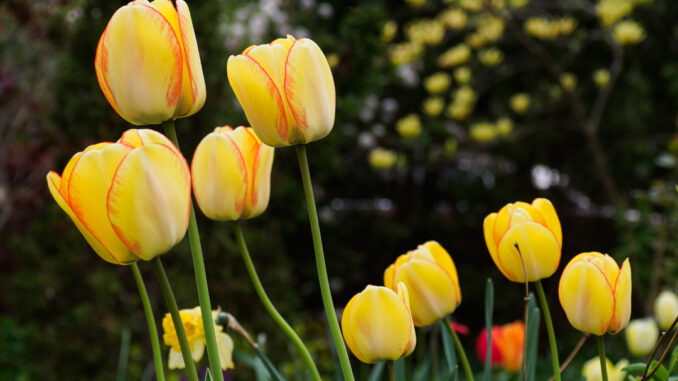
It’s finally summer and we should enjoy the moment, while considering how to get the best from roses blooming in the garden right now. But the early arrival of fall bulb catalogues suggests the intriguing possibility of perennial spring bulb bloom. There are new ideas to consider!
More and better roses
The most practical way to keep roses blooming is by providing fertilizer that encourages flower development. Commercial rose fertilizers contain the major elements of plant growth – nitrogen, phosphorous and potassium – in an analysis that is specific to flower bud development. The middle number in the analysis will always be higher; for example, 10-15-10. Roses can be fertilized in spring after buds break and twigs with leaves are present along the canes. A second application can be made in late June to early July when the first flush of rose blooms is finishing; and a third application in late summer (in the first two weeks of August).
Following this schedule will keep rose shrubs producing flowers through the full growing season and into early autumn. The schedule is focused on maximum flower production within the available weeks before frost shuts down plant’s productivity. With so much focus on producing blooms, there is little energy directed toward enlarging the shrub with new cane growth. Consequently, roses that are aggressively fertilized over several years may eventually suffer structural exhaustion. Too much is being asked of the woody plant canes without any structural growth of new wood. The plant may eventually appear diminished and become less productive.
An effective way to get more rose production over a longer period of years is to encourage growth of the full shrub. As a rose shrub produces flowers over the growing season, it should also be replacing older wood with new canes that will enlarge the plant. A simple way to provide essential elements to trigger new rose cane growth is by providing common Epsom salt, which contains magnesium and sulfur. Magnesium assists in chlorophyll production, part of the energy needed for cane growth, and also enhances petal size and colour. Sulfur is essential to protein production, an important element in growth. Provided together, magnesium and sulfur encourage new cane development from the lower portions of the shrub, providing architecture for increased flowering wood. Supplying Epsom salt every year usually results in growing new cane wood.
Epsom salt doesn’t replace standard rose fertilizer, but is used as an amendment to healthy growth. Spring is the most important time to provide Epsom salt, when the plant is ready for strong growth. Apply ½ cup of Epsom salt to the soil surrounding an established shrub, keeping it away from direct contact with the plant base. Use a hand cultivator or trowel to work the Epsom salt into the top layer of soil and water it thoroughly. Use ¼ cup of Epsom salt mixed into the hole when installing new rose plants, and up to ½ cup worked into the topsoil for established roses. The Epsom salt can be provided every four to six weeks through the growing season to enhance the size and colour of flower petals.
Long returns from perennial spring bulbs
It’s always a surprise to receive autumn bulb catalogues when we’re just into the best weeks of summer. There’s a leap of faith in selecting autumn-planted spring bulbs, with our hopes pinned on these brilliant catalogue pictures. They are costly displays, and how many years of return blooming can we expect?
Return blooming is encouraged by good care. All bulbs benefit from at least three hours of sun. Deadheading seed heads promptly after the blossoms are finished and the green foliage remains standing also prolongs bulb viability. But the best results come from planting genuinely perennial bulbs. With good care, perennial bulbs will potentially deliver flowers for several years, and possibly for a decade.
It seems too good to be true, but there are autumn-planted spring bulbs with true perennial potential. It’s not a full list of spring flowers, but there is enough choice and colour potential to make an impressive spring display. Look for the category of Darwin tulips with recognized natural longevity. Darwins are tall tulips with classic large flower heads, and their colours include warm yellow and orange, light to rich pink, bold red and a selection of fancy bicolours. They bloom in mid-spring, from early to late May. You can expect them to return for several years – possibly for a decade, and even longer. Darwin tulips are easy to find and will be identified in bulb catalogues.
Smaller bulbs producing early spring flowers in April include the bright yellow-and-white mini tulip Daisystemon Tarda, growing four inches high and producing multiple flowers per bulb. Glory of the Snow, or Chionodoxa luciliae, with bright cornflower-blue flowers and white up-facing throats sparkle in frosty temperatures and clusters each year. They are followed by the down-facing dark blue heads of Siberian squills, or Scilla siberica. Siberian squills are low-growing bulbs that will return for decades and may spread, but are not considered invasive. Because of their ephemeral nature, the green foliage dies down shortly after flowering.
The large group of flowering onions, known as ornamental alliums, contains two beautiful perennial specimens. Allium Purple Sensation is a dense globe of electric purple petals held high on 18-inch stems. Planted in groups, they make a striking image, emerging above plants such as hostas. Allium bulgaricum is a one-of-a-kind flower unlike any other. Individual purple-and-white bells hang in loose umbels from a central 36-inch stem. Just three planted in a cluster makes an intriguing statement.
A good strategy for planting bulbs in fall is to consider these perennial spring bloomers as the backbone planting that can be counted on to bloom for many years. Each year, a few desirable favourites can be added – such as narcissus – and novelties, such as parrot tulips. The cost will be lower and the rewards will continue to be high.


